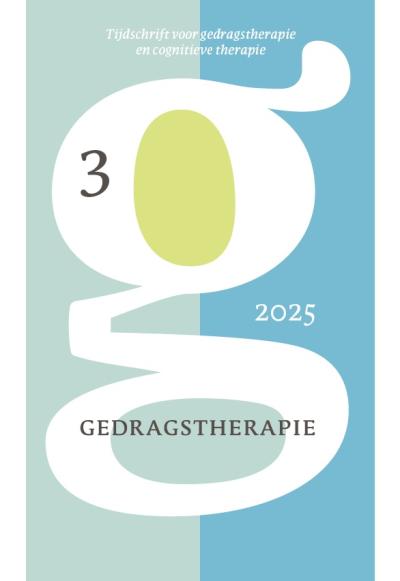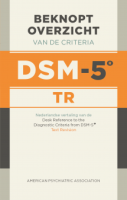Inhoud
Affirmatieve cognitieve gedragstherapie voor homoseksuele, lesbische en biseksuele cliënten
Samenvatting
In dit artikel wordt een overzicht gegeven van affirmatieve cognitieve gedragstherapie voor homoseksuele mannen, lesbische vrouwen en biseksuelen. Eerst wordt dieper ingegaan op de affirmatieve cognitieve gedragstherapie, waarbij een empathische behandeling zonder vooroordelen centraal staat en de identiteit als homoseksueel, lesbienne of biseksueel (holebi) door de therapeut bevestigd en versterkt wordt. Vervolgens worden belangrijke zaken besproken waar therapeuten van ‘holebi's' kennis van zouden moeten hebben, zoals identiteitsontwikkeling, stigmatisering en intieme relaties. Hierna wordt stil gestaan bij richtlijnen om vooroordelen te voorkomen tijdens de therapie. Tot slot worden suggesties gegeven voor toekomstig onderzoek naar affirmatieve cognitieve gedragstherapie.
Literatuur
- American Psychological Association (2011). Sexual orientation and homosexuality. Gevonden op het internet op 13 November 2011: http://www.apa.org/helpcenter/sexual-orientation.aspx.
- Arntz, A. & Smeets, G. (2009). Cognitieve therapie. In G. Smeets, A.E.R. Bos, H.T. van der Molen & P. Muris (Red), Klinische psychologie: Diagnostiek en therapie. Groningen: Uitgeverij Noordhoff.
- Batson, C.D., Polycarpou, M.P., Harmon-Jones, E., Imhoff, H.J., Mitchener, E.C., Bednar, L. L., Klein, T.R., & Highberger, L. (1997). Empathy and attitudes: Can feeling for a member of a stigmatized group improve feelings toward the group? Journal of Personality and Social Psychology, 72, 105-118.
- Bos, A.E.R., Kanner, D., Muris, P., Janssen, B., & Mayer, B. (2009). Mental illness stigma and disclosure: Consequences of coming out of the closet. Issues in Mental Health Nursing, 30, 509-513.
- Bos, A.E.R., Schaalma, H.P., & Pryor, J.B. (2008). Reducing AIDS-related stigma in developing countries: The importance of theory- and evidence-based interventions. Psychology, Health & Medicine, 13, 450-460.
- Burri, A., Rahman, Q., Santtila, P., Jern, P., Spector, T., & Sandnabba, K. (in druk). The relationship between same-sex sexual experience, sexual distress, and female sexual dysfunction. The Journal of Sexual Medicine.
- Cass, V.C. (1979). Homosexual identity formation: A theoretical model. Journal of Homo sexuality, 4, 219-235.
- Chivers, M.L. (2005).A brief review and discussion of sex differences in the specificity of sexual arousal. Sexual and Relationship Therapy, 20, 377-390.
- Cochran, S.D., Sullivan, J.G., & Mays, V.M. (2003). Prevalence of mental disorders, psychological distress, and mental health services use among lesbian, gay, and bisexual adults in the United States. Journal of Consulting and Clinical Psychology, 71, 53-61.
- Corliss, H.L., Rosario, M., Wypij, D., Fisher, L.B., & Austin, S. (2008). Sexual orientation dis parities in longitudinal alcohol use patterns among adolescents: Findings from the growing up today study. Archives of Pediatrics & Adolescent Medicine, 162, 1071-1078.
- De Graaf, H., Meijer, S., Poelman, J., & Vanwesenbeeck, I. (2005). Seks onder je 25ste: Seksuele gezondheid van jongeren in Nederland anno 2005. Delft: Rutgers Nisso Groep / SOA AIDS Nederland.
- De Graaf, R., Sandfort, T.H.M., & Ten Have, M. (2006). Suicidality and sexual orientation: Differences between men and women in a general population-based sample from the Netherlands. Archives of Sexual Behavior, 35, 253-262.
- Diamond, L.M. (2008). Female bisexuality from adolescence to adulthood: results from a 10-year longitudinal study. Developmental Psychology, 44, 5-14.
- Diamond, L.M., & Butterworth, M. (2008). Questioning gender and sexual identity: Dynamic links. Sex Roles, 59, 365-376.
- Dijker, A.J., & Koomen, W. (2003). Extending Weiner's attribution-emotion model of stigmatization of ill persons. Basic and Applied Social Psychology, 25, 51-68.
- Drescher, J. (2010). Queer diagnoses: Parallels and contrasts in the history of homosexuality, gender variance, and the diagnostic and statistical manual. Archives of Sexual Behavior, 39, 427-460.
- Emmelkamp, P. & Vedel, E. (2009). Gedragstherapie. In G. Smeets, A.E.R. Bos, H.T. van der Molen & P. Muris (Red), Klinische psychologie: Diagnostiek en therapie. Groningen: Uitgeverij Noordhoff.
- Franssens, D., & Hospers, H. (2009). Outcomes. Maastricht: Universiteit Maastricht.
- Gellman, B.D. (1986). Sexual function and dysfunction in homosexual males. Dissertation Abstracts International, 46, 3215.
- Glover, J.A., Galliher, R.V., & Lamere, T.G. (2009). Identity development and exploration among sexual minority adolescents: Examination of a multidimensional model. Journal of Homosexuality, 56, 77-101.
- Goffman, I. (1963). Stigma: Notes on the Management of Spoiled Identity. Eaglewood Cliffs, NJ: Prentice-Hall.
- Gruskin, E.P., Greenwood, G.L., Matevia, M., Pollack, L.M., & Bye, L.L. (2007). Disparities in smoking between the lesbian, gay, and bisexual population and the general population in California. American Journal of Public Health, 97, 1496-1502.
- Haddock, G., & Zanna, M. (1998). Authoritarianism, values, and the favorability and structure of anti-gay attitudes. In G.M. Herek (Ed), Stigma and sexual orientation: Understanding prejudice against lesbians, gay men, an bisexuals (pp. 82-107). Newburry Park, CA: Sage.
- Halpin, S.A., & Allen, M.W. (2004). Changes in psychosocial well-being during stages of gay identity development. Journal of Homosexuality, 47, 109-127.
- Hebl, M.R., Tickle, J., & Heatherton, T.F. (2000). Awkward moments in interactions between nonstigmatized and stigmatized individuals. In T. F. Heatherton, R. E. Kleck, M. R. Hebl & J. G. Hull (Eds.), The social psychology of stigma (pp. 243-272). New York: Guilford Press.
- Henderson, A.W., Lehavot, K., & Simoni, J.M. (2009). Ecological models of sexual satisfaction among lesbian/bisexual and heterosexual women. Archives of Sexual behaviour, 38, 50-65.
- Hendrickx, D., & Lietaer, G. (2003). Affirmatieve hulpverlening aan homoseksuele mannen: Enkele thema's. Tijdschrift voor psychotherapie, 29, 309-327.
- Herek, G.M. (2000). The psychology of sexual prejudice. Current Directions in Psychological Science, 9 , 19-22.
- Herek, G.M. (2009). Hate crimes and stigma-related experiences among sexual minority adults in the United States: Prevalence estimates from a national probability sample. Journal of Interpersonal Violence, 24, 54-74.
- Herek, G.M. & Capitanio, J. (1996). 'Some of my best friends': Intergroup contact, concealable stigma, and heterosexuals' attitudes towards gay men and lesbians. Personality and Social Psychology Bulletin, 22, 412-424.
- Herek, G.M. & Capitanio, J. (1999). Sex differences in how heterosexuals think about lesbians and gay men: Evidence from survey context effects. Journal of Sex Research, 36, 348-360.
- Herek, G.M., & Garnets, L.D. (2007). Sexual orientation and mental health. Annual Review of Clinical Psychology, 3, 353-375.
- Hirshfield, S., Chiasson, M., Wagmiller, R.L., Remien, R.H., Humberstone, M., Scheinmann, R., & Grov, C. (2010). Sexual dysfunction in an internet sample of U.S. men who have sex with men. The Journal of Sexual Medicine, 7, 3104-3114.
- Horowitz, J.L., & Newcomb, M.D. (2001). A multidimensional approach to homosexual identity. Journal of Homosexuality, 42, 1-19.
- Joling, E.J., Bos, A.E.R., & Sandfort, T. (2003). Discriminatie van homoseksuele mannen en lesbische vrouwen op het werk: Een onderzoek naar de relatie tussen homodiscriminatie, coping en gezondheid. In E. van Dijk, E. Kluwer & D. Wigboldus (Red), Jaarboek Sociale Psychologie 2002. Delft: Eburon.
- Katz-Wise, S.L., & Hyde, J.S. (2012). Victimization experiences of lesbian, gay, and bisexual individuals: A meta-analysis. Journal of Sex Research, 49, 142-167.
- Kawakami, K., Dovidio, J.F., Moll, J., Hermsen, S., & Russin, A. (2000). Just say no (to stereotyping): Effects of training in the negation of stereotypic associations on stereotype activation. Journal of Personality and Social Psychology, 78, 871-888.
- Kort, J. (2008). Gay affirmative therapy for the straight clinician. The essential guide. New York: W.W. Norton & Company Inc.
- Kunda, Z., & Oleson, K.C. (1995). Maintaining stereotypes in the face of disconfirmation: Constructing grounds for subtyping deviants. Journal of Personality and Social Psychology, 68, 565-579.
- Kunda, Z., & Oleson, K.C. (1997). When exceptions prove the rule: How extremity of deviance determines the impact of deviant examples on stereotypes. Journal of Personality and Social Psychology, 72, 965-979.
- Kurdek, L.A. (2005). What do we know about gay and lesbian couples? Current Directions in Psychological Science, 14, 251-254.
- Kuyper, L.S. (2011). Sexual orientation and health: General and minority stress factors explaining health differences between lesbian, gay, bisexual, and heterosexual individuals. Universiteit Utrecht: Academisch proefschrift.
- Kuyper, L., & Fokkema, T. (2011). Minority stress and mental health among Dutch LGBs: Examination of differences between sex and sexual orientation. Journal of Counseling Psychology, 58, 222-233.
- Macrae, N., Bodenhausen., G.V., Milne, A.B. & Jetten, J. (1994). Out of mind but back in sight: Stereotypes on the rebound. Journal of Personality and Social Psychology, 67, 808-817. Martell, C.R., Safren, S.A., & Prince, S.E. (2004). Cognitive-behavioral therapies with lesbian, gay and bisexual clients. New York: The Guilford Press.
- Mevissen, F.E.F., Bos, A.E.R., Pryor, J.B., De Haas, K., Van Empelen, P., & Kok, G. (2011). Antecedents of sexual prejudice among adolescents. Poster gepresenteerd op de 25ste EHPS conferentie in Kreta.
- Meyer, I.H. (1995). Minority stress and mental health in gay men. Journal of Health and Social Behavior, 36, 38-56.
- Meyer, I.H. (2003). Prejudice, social stress, and mental health in lesbian, gay, and bisexu al populations: Conceptual issues and research evidence. Psychological Bulletin, 129, 674-697.
- Milton, M., & Coyle, A. (1999). Lesbian and gay affirmative psychotherapy: Issues in theory and practice. Sexual and Marital Therapy, 14, 43-59.
- Moritz, V., & Bos, A.E.R. (2012). Affirmatieve cognitieve gedragstherapie voor homoseksuele, lesbische en biseksuele cliënten: Twee gevalsbeschrijvingen. Gedragstherapie, 45, 215-226.
- Pachankis, J.E. (2007). The psychological implications of concealing a stigma: A cognitive-affective-behavioral model. Psychological Bulletin, 133, 328-345.
- Pachankis, J.E., & Goldfried, M.R. (2004). Clinical issues in working with lesbian, gay, and bisexual clients. Psychotherapy: Theory, Research, and Practice, 41, 227-246.
- Pedersen, W., & Kristiansen, H.W. (2008). Homosexual experience, desire and identity
- among young adults. Journal of Homosexuality, 54, 68-102.
- Pennebaker, J.W. (1990). Opening up: The healing power of confiding in others. New York: Morrow.
- Pettigrew, T.F. & Tropp, L.R. (2006). A meta-analytic test of intergroup contact theory. Journal of Personality and Social Psychology, 90, 751-783.
- Pettigrew, T.F., Tropp, L.R., Wagner, U., & Christ, O. (2011). Recent advances in intergroup contact theory. International Journal of Intercultural Relations, 35, 271-280.
- Pryor, J., Reeder, G.D., Yeadon, C., & Hesson-McLnnis, M. (2004). A dual-process model of reactions to perceived stigma. Journal of Personality and Social Psychology. 87, 436-452.
- Ritter. KY., & Terndrup, A.I. (2002). Handbook of affirmative psychotherapy with lesbians and gay men. New York: Guilford.
- Rock, M., Stone Carlson, T., & McGeorge, C.R. (2010). Does affirmative training matter? Assessing CFT students' beliefs about sexual orientation and their level of affirmative training. Journal of Marital and Family Therapy, 36, 171-184.
- Rosario, M., Schrimshaw, E.W., & Hunter, J. (2011). Different patterns of sexual identity development over time: Implications for the psychological adjustment of lesbian, gay, and bisexual youths. Journal of Sex Research, 48, 3-15.
- Rutgers Nisso Groep (2006). Seksuele gezondheid in Nederland 2006. Delft: Eburon.
- Sandfort, T.G.M., Bakker, F., Schellevis, F., & Vanwesenbeeck, I. (2006). Sexual orientation and mental and physical health status: Findings from a Dutch population survey. American Journal of Public Health, 96,1119-1125.
- Sandfort, T.G.M., De Graaf, R., Bijl, R.V., & Schnabel, P. (2001). Same-sex sexual behavior and psychiatric disorders. Archives of General Psychiatry, 58, 85-91.
- Sandfort, T.G.M., De Graaf, R., & Bijl, R.V. (2003). Same-sex sexuality and quality of life: Findings from the Netherlands mental health survey and incidence study. Archives of Sexual Behavior, 32, 15-22.
- Sandfort, T.G.M., & De Keizer, M. (2001). Sexual problems in gay men: An overview of empirical research. Annual Review of Sex Research, 12, 93-120.
- Savin-Williams, R.C. (2011). Identity development among sexual-minority youth. In S.J. Schwartz, K. Luyckx & V.L. Vignoles (Eds), Handbook of Identity Theory and Research. New York: Springer.
- Schoonacker, M., Dumon, E., & Louckx (2009). Welebi: Onderzoek naar het mentaal en sociaal welbevinden van lesbische en biseksuele meisjes. Brussel: Vrije Universiteit Brussel.
- Stutterheim, S.E., Shiripinda, I., Bos, A.E.R., Pryor, J.B., De Bruin, M., Nellen, J.F.J.B., Kok, G., Prins, J.M., & Schaalma, H.P. (2011). HIV status disclosure among HIV positive African and Afro-Caribbean people in the Netherlands. AIDS Care, 23, 195-205.
- Troiden, R.R. (1989). Becoming homosexual: A model of gay identity acquisition. Psychiatry, 42, 288-299.
- Van Empelen, P., Van Berkel, M., Roos, E., & Zuilhof, W. (2010). Schorer Monitor 2010. Amsterdam: Schorer.
- Van Empelen, P., Van Berkel, M., Roos, E., & Zuilhof, W. (2011). Schorer Monitor 2011. Amsterdam: Schorer.
- Vanwesenbeeck, I. (2009). Seksuele diversiteit. In L. Gijs, W. Gianotten, I. Vanwesenbeeck & P. Weijenborg, Seksuologie. Houten: Bohn Stafleu Van Loghum.
 © 2009-2025 Uitgeverij Boom Amsterdam
© 2009-2025 Uitgeverij Boom Amsterdam
De artikelen uit de (online)tijdschriften van Uitgeverij Boom zijn auteursrechtelijk beschermd. U kunt er natuurlijk uit citeren (voorzien van een bronvermelding) maar voor reproductie in welke vorm dan ook moet toestemming aan de uitgever worden gevraagd:
Behoudens de in of krachtens de Auteurswet van 1912 gestelde uitzonderingen mag niets uit deze uitgave worden verveelvoudigd, opgeslagen in een geautomatiseerd gegevensbestand, of openbaar gemaakt, in enige vorm of op enige wijze, hetzij elektronisch, mechanisch door fotokopieën, opnamen of enig andere manier, zonder voorafgaande schriftelijke toestemming van de uitgever.
Voor zover het maken van kopieën uit deze uitgave is toegestaan op grond van artikelen 16h t/m 16m Auteurswet 1912 jo. Besluit van 27 november 2002, Stb 575, dient men de daarvoor wettelijk verschuldigde vergoeding te voldoen aan de Stichting Reprorecht te Hoofddorp (postbus 3060, 2130 KB, www.reprorecht.nl) of contact op te nemen met de uitgever voor het treffen van een rechtstreekse regeling in de zin van art. 16l, vijfde lid, Auteurswet 1912.
Voor het overnemen van gedeelte(n) uit deze uitgave in bloemlezingen, readers en andere compilatiewerken (artikel 16, Auteurswet 1912) kan men zich wenden tot de Stichting PRO (Stichting Publicatie- en Reproductierechten, postbus 3060, 2130 KB Hoofddorp, www.cedar.nl/pro).
No part of this book may be reproduced in any way whatsoever without the written permission of the publisher.
Inloggen VGCt en VVGT
Leden van de VGCt en de VVGT loggen in via de site van hun vereniging. Als u op die site bent ingelogd als lid, vindt u daar een button naar het Tijdschrift voor Gedragstherapie.
English
Behavioral Therapy: Journal for Behavioral Therapy and Cognitive Therapy ISSN 0167-7454
Information in English can be found here.







